Hello!
Today I’ll look into an archetype from the old school of M:TG, the Red Sligh.
A Bit of History
This deck was named after its designer, Paul Sligh, who took it into a second place in a PTQ (yeah, back in the days it was a great achievement). The deck is a variation of the already known and established RDW – Red Deck Wins, a very aggressive mono-Red deck with fast beaters and burn spells, or the 20-20-20 that stood for 20 lands, 20 creatures and 20 spells, also a mono-Red build.
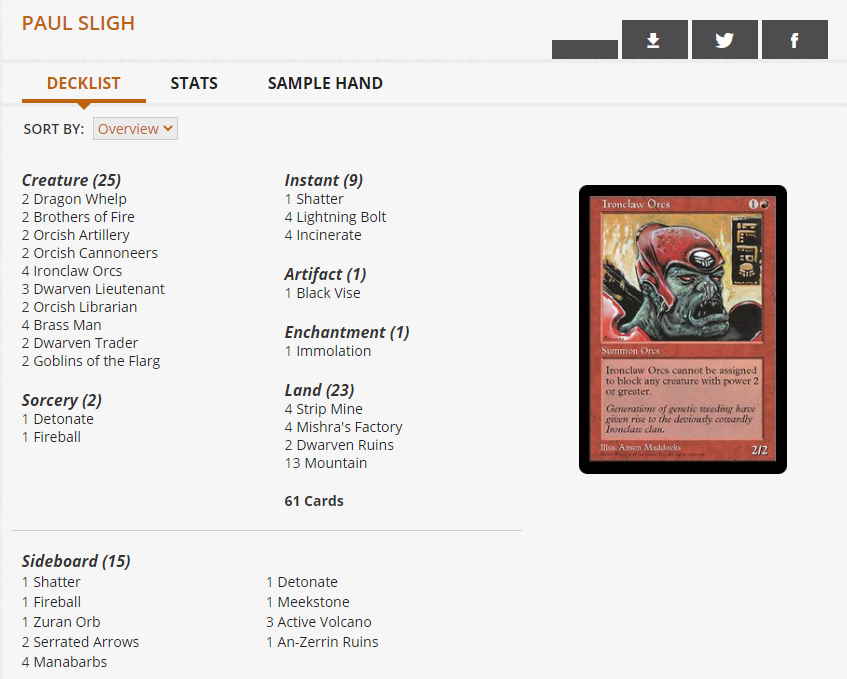
Paul didn’t do anything different from the original RDW created by Jay Schneider, who used 4 copies of Ironclaw Orcs, the mean looking Orc Jay is facing. Paul incorporated the deck and gave a Curve feel to it, curving really well aggressive creatures and topping that with burn spells.
Remember these were the days of Necropotence so a deck needed to be fast and hit hard.
But after Paul others came along and followed a principle, not directly created by Paul himself but by huge inspiration on his take of the normal RDW deck. And that principle was what made it famous, even creating the slang Sligh Players, that represented players who played RDW decks in tournaments but also reffering to this specific archetype.
The Sligh Principle is an ideal, a strategy of play.
It was a deck I personally played back in the Tempest Standard days. It was a cheap deck to assemble since it used mostly commons but it was fast and strong.

This was the version that inspired my deck.
It used a lot of cheap threats backed up by Rathi Dragon as a finisher in the air with some burn spells in the mix. Cursed Scroll was a powerhouse in the format and specially in this deck since it could dump the hand really fast and keep one card back to use its ability.
But only when Shock was printed, back in Stronghold, is when the true Sligh philosophy takes place.

This deck above is the final and polished version of Sligh.
The Sligh Principle is simple. You play a fast beater, in this case any of the Goblins, and keep beating. Burn spells are not used in the opponent’s face as they were in earlier versions but they are used in the opponent’s creatures instead. That’s why Shock was relevant, it was a cheap spell that could remove an early blocker in the same turn after playing an Echo cost.
You see, this deck uses 22 burn spells, 26 counting the 4x Seal of Fire. They could also point face but they were used mostly as straight removal so the 2/x creatures could do their swing. And Viashino Cutthroat also doing its thing.
Pauper Sligh
I’ve tried to port this deck into Pauper. Is not that difficult since most of the Sligh builds used a lot of Commons, from creatures to Burn spells, all are Commons.
The issue is the format itself. Back in the days of Standard and as Standard still is, removal is premium. In Pauper, spot removal is as common as our Cause. It’s everywhere!
And that makes any cheap creature as those used in those decks a bit frail when facing heavy removal decks.
The most famous RDW deck in Pauper is the Goblins version that saturates the field with Goblins and uses Goblin Grenade as a cheap finisher. It is not a Sligh deck since it does not play by the same principle.
And there is also the Burn version… I do not like that archetype in Pauper since it’s a make-or-break deck with no backup plan.
But with a new edition approaching and new cards coming up, I see a potential for this archetype.

The ‘Boat.
This is an interesting card.
As it stands, I think it’s pretty honest. CMC:2 for a 3/3 Vehicle, has a Crew:1. All ok.
Its ability is Vigilance, which I think it’s also ok. It can attack and then it can block if have two 1/1’s to spare. It can surely be a Turn#2 blocker. And 3 Power is something to take in consideration.
But there’s a problem. The ‘Boat itself is susceptible to spot removal. And without a Crew it’s a dead draw. But it was the card that got me thinking if it was possible to turn it into a piece in a Sligh deck.
Yes, it can be. But again, you’ll need to saturate the field to force your opponent spending removal in something else.
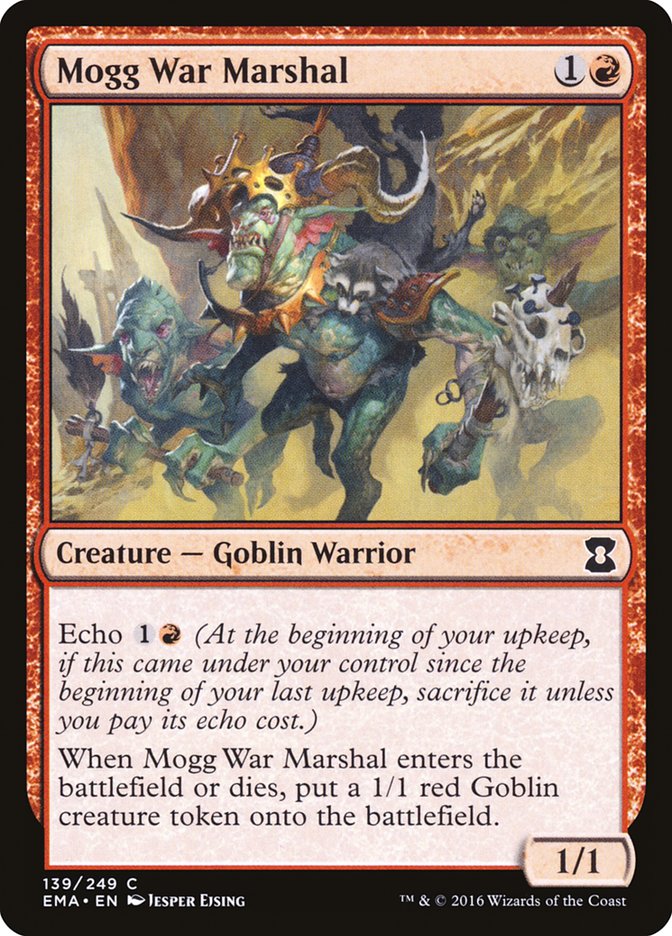
A good way to do that is playing the War Marshal.
This card is a 3-for-1 by itself and becomes pretty relevant with the ‘Boat because by itself it turns the ‘Boat in an attacked and a blocker in the next turn.
Being a Goblin and creating Goblins it also poses the threat of Goblin Grenade, a 5 damage in the face at the expense of R and one Goblin. And in Pauper, that threat is a reality.
I think the ‘Boat can do some work in some RDW builds. Because the ‘Boat is a 3/3 body and it can cut through some early blockers that would trade with the red x/1’s.
But I thought in another way to use it.
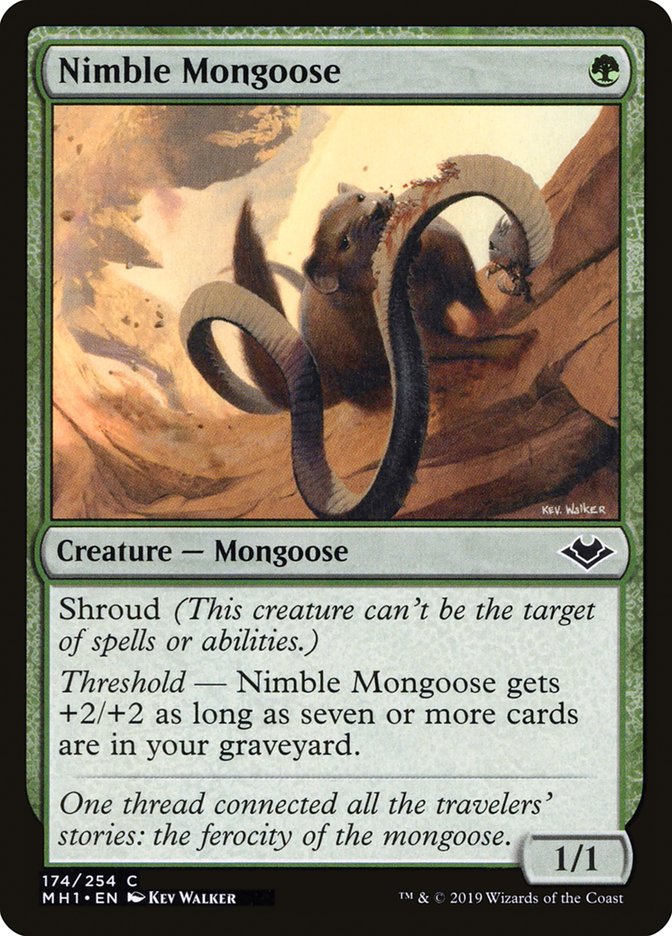
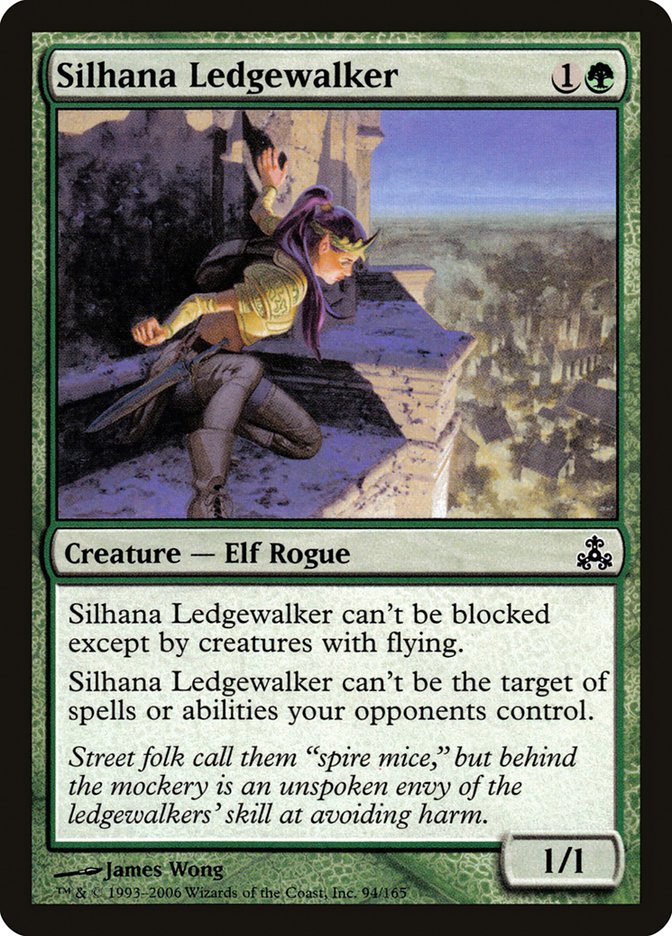
Yeah, why not using creatures with Protection that would crew the ‘Boat?
But that would be dumb… it would make my opponent keep their removal in hand and then deal with ‘Boat. And the ‘Boat is an Artifact and we know Abrade is in the format.
But all of this is to explain to you my line of thought.
I started by looking at a Vehicle that could do some work in a mono-R build and then transition myself into something else. The brain gears and clogs all working together.
Mongoose is a great creature to use in a Sligh principle. It dodges removal by itself and in a later stage it turns into a beater. In a 20-20-20 deck, it is pretty easy to turn it into a 3/3 mid-game.
The Elf is also a good creature to have. Not only because of its inbuilt protection but also because of its natural evasion. Also, the Elf can become Rancorous in a mid-to-late stage or pumped in other ways.
And then… we’ll also have some new spicy Dual Lands that also have to be Snow permanents and allow more freedom of choice for some custom builds.
Gruul Sligh
Having the Sligh Principle in mind, the really best way to do it is by playing a Gruul shell, a RG shell.
Green gives cheap threats with inbuilt protection. It also offers pump spells, pump auras and pump effects.
Red gives burn spells to act like spot removal or to finish the race.
Threats
I’ve already mentioned two threats. That represents 8 cards in a deck if you use full sets.
But we need some more.
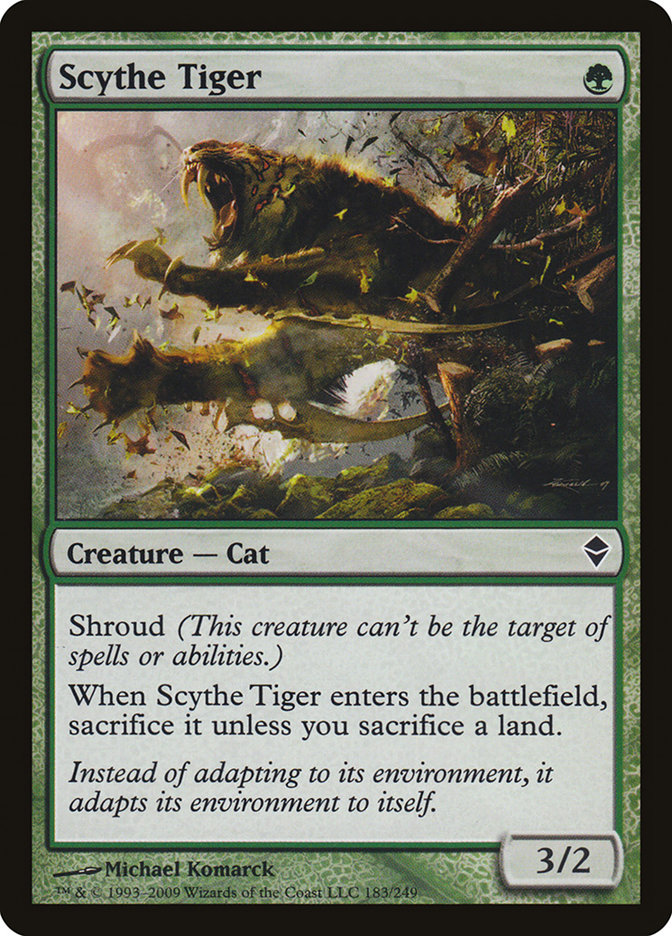
This card is normally considered card disadvantage since it removes one Land from the field and is traded with pretty much anything.
But… in the right scenario this card can thrive.
It corresponds to what is the Sligh Principle. It’s a cheap threat. An early game beater. It dodges spot removal.
Yes, the Land loss may be a steep price to pay but… it’s a Turn#1 3/2. It will not be Bolt’d, it will not be Cast’d Down. It only suffers from early Edict’s, that’s a thing. It also suffers to mid-game Cannonade. But in any way it’s still better than a Boggle.
If we get this Cat in the field and use a lot of R removal to clear its path, it’s a clock as good as the Delver of Secrets clock. With the particularity to dodge removal.
If we use full-sets for Tiger, Elf and Mongoose we get into the 12-creature spot Sigurd Eskeland used in his deck. We will not have a big beater but all our threats have protection against opponent’s spot removal, turning it into dead cards.
Removal
Apart from Bolts and spice and everything nice, one card has become even more spicy!
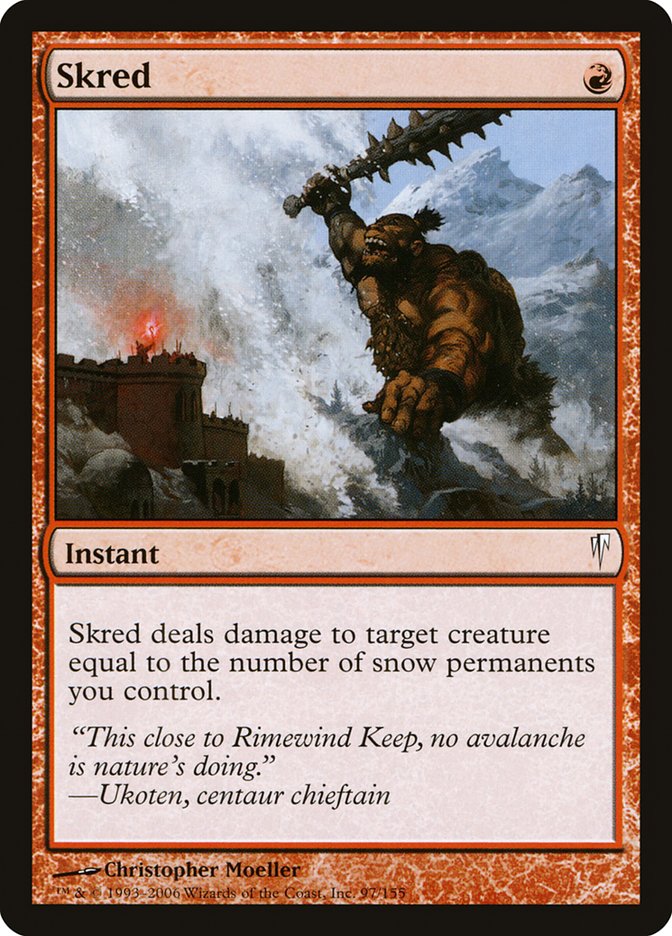
Have you read the latest article on Common Cause?
That’s how important this card is.
With the new Dual lands, not only we can splash for colors but we can also improve the Skred count. And improve Skred into a kill-any-creature-in-the-meta spell. Almost any creature.
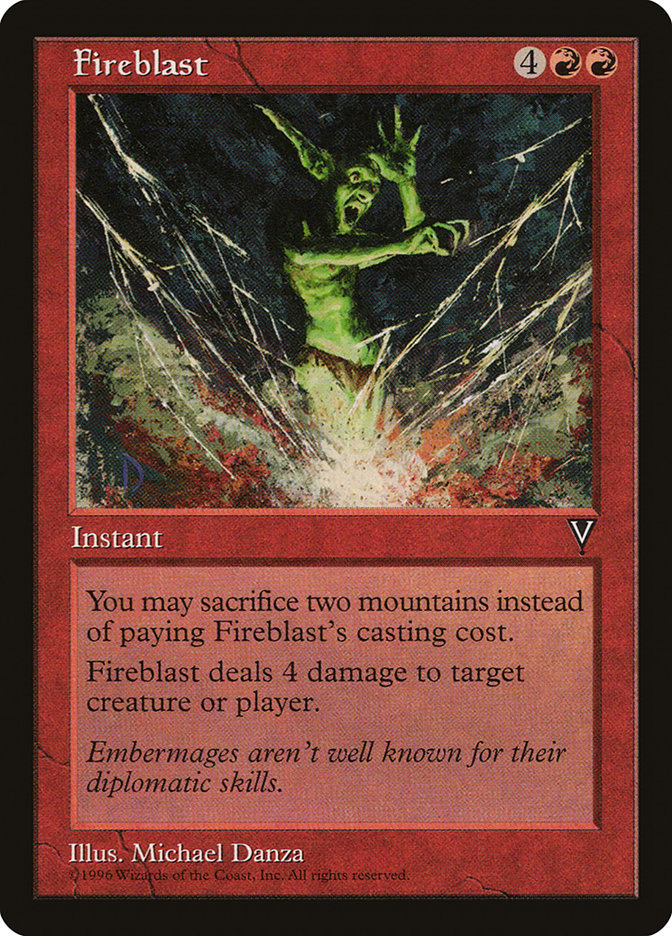
This sleeper has awaken!
The Dual Lands are, indeed, Duals. They have two types of Lands. That means that the RG Dual also counts as a Mountain. And also counts for this card.
This is a clear example of the missing power in most card analysis regarding the new Duals. People tend to forgot that are many ways, many small synergies that gain something from a Land having two different types.
And with that, Fireblast becomes a viable finisher and also another viable removal card, if in need for that.

Another way to finish the game and turn a 1/1 into some damage is Reckless Abandon.
It’s the poor cousin of Goblin Grenade but in a deck that does not have Goblins and has creatures that dodge removal, this can cash in at any time.
Remember that Shroud works with this card since this card does not target the creature it requires the sacrifice. It works like an Edict but in a good way!
It can also work as a removal spell but is not efficient that way.
Deck List
Remember, we don’t have the lands yet so this is all part of speculation.
I’ve been doing some tests but without the new Duals. And those Lands gave a whole new dynamic to the deck, so bear in mind this is just a rough sketch.
Creatures (12):
4x Scythe Tiger
4x Nimble Mongoose
4x Silhana Ledgewalker
Spells (32):
4x Lightning Bolt
4x Skred
4x Abrade
4x Needle Drop
3x Searing Blaze
3x Flame Slash
2x Firebolt
2x Fireblast
2x Reckless Abandon
1x Scalding Cauldron
3x Land Grant
Lands (16):
4x Highland Forest
5x Snow-Covered Forest
7x Snow-Covered Mountain
To sum it up, 16 Lands because the curve is low.
Land Grant to fetch the Duals.
A good Burn package backed by the untouchable creatures.
Scalding Cauldron is more of a SB card against Guardian of the Guildpact.
Against tokens, Boggles and whatnot we can trade some of the removal for go-wide removal like Electrickery, Fiery Cannonade and/or Swirling Sandstorm.
Can also include Pulse of Murasa and/or Weather the Storm for some gains… although, this is a race deck, an aggro deck. It does not want to get stuck in midrange and gaining life.
And that’s it.
Hope you liked it. It’s still a very rough sketch and I also want to test the main idea with the ‘Boat in a mono-R shell with a more go-wide feel to it.
Shroud yourself from Covid. Take care.
